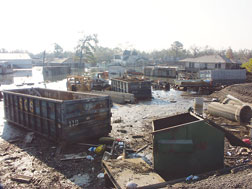Following the disaster of Hurricane Katrina, the Chief of the Army Corps of Engineers established the Interagency Performance Evaluation Task Force to determine why the hurricane protection system in New Orleans failed. The task force consisted of over 300 experts from 25 universities, 23 firms and eight government agencies. Unparalleled in scope and depth of analysis, its findings tell only a part of the story.
 Tom Sawyer/ENR |
Katrina generated the largest storm surge to hit North America. Coupled with long-period waves, it overtopped and overwhelmed many hurricane protection structures. Much of what has been written since Katrina has focused on agency responsibilities or the implications of specific events. Too little attention has been paid to the bigger picture—the major forces long at work behind the scenes.
Even before Katrina, the nature of the storms threatening New Orleans, the character of the hurricane protection system and the consequences of flooding were changing. The "Standard Project Hurricane," defined in 1965 as having up to a 1:300 annual chance of occurrence, in 2005 no longer equated to even a 1:100 event. The protection system was in a constant state of construction, with some areas not scheduled for completion until 2015. The area also was subsiding, resulting in some structures 2 to 3 ft below their authorized elevations. As more people and property occupied former marsh lands, the consequences of flooding, property loss and loss and disruption of lives increased dramatically.
Knowledge was evolving slowly. Information about the failure mechanism that ultimately triggered four of the floodwall failures was emerging at about the same time the structures were being designed.
|
Compromise also was at work. The original plan for protecting New Orleans was focused on life safety, not economics. It was a systems approach dimensioned to deal with the "most severe likely storm" for the region. But what was being put in place was significantly less, the result of many incremental compromises.
Cost was one of the major drivers. Extensive sections of levee were constructed using material dredged from adjacent channels and capped with clay. Floodwalls and levees were not armored against erosion, and some floodwalls were designed with marginal factors of safety. They were not designed to withstand overtopping and, for the most part, they performed exactly as designed.
Complacency compounded things. New Orleans last flooded significantly in 1965. In the ensuing 40 years there had been no catastrophes. Issues such as the subsidence and storm intensities were known but deliberate decisions were made not to interrupt construction to change the design because the process was too ponderous and inflexible.
 Link
|
And then there was little will power. We lack the national will to deal with long-term hazards. We are more oriented to budget and election cycles than the life cycle appropriate for infrastructure and natural hazards. We can blame the political system, but as citizens we have elected the policies. Their impact extends far beyond New Orleans—west to Sacramento and east to Lake Okeechobee. In short, Katrina had us with risk up and guard down.
To address these issues, we must think big picture and long term. While important, reform of individual components or practices will not solve the problem. It requires adopting a risk-based systems approach from the top echelons of Washington down to the realities of local community needs and resources. Katrina was the latest in a series of wake-up calls. It is time to stay awake and develop the necessary long-term solutions.
 Related Links:
Related Links: 
Post a comment to this article
Report Abusive Comment